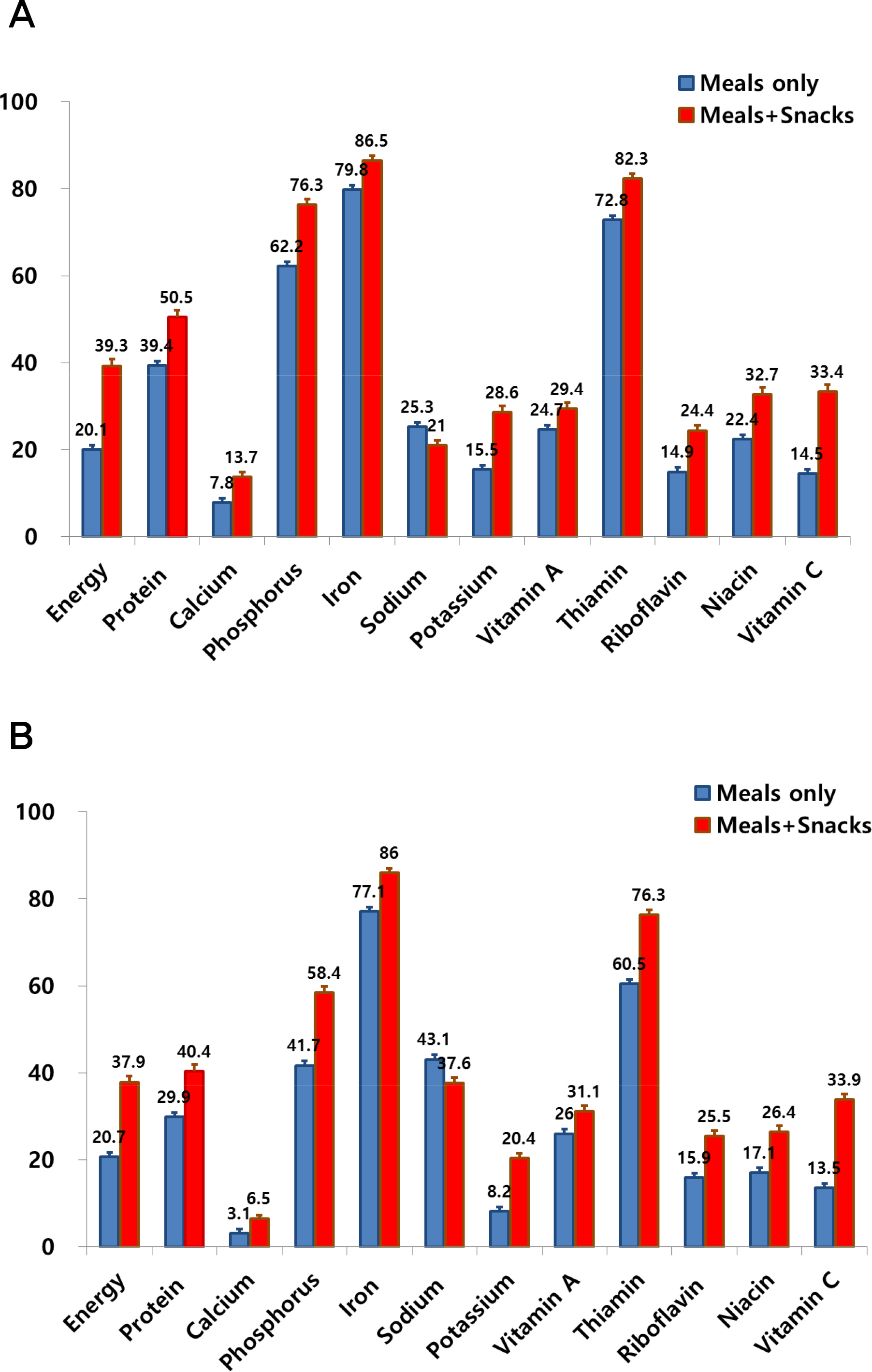References
1. Brownie S. Why are elderly individuals at risk of nutritional deficiency? Int J Nurs Pract 2006;12(2):110–8.
2. Kwon SO, Oh SY. Associations of household food insecurity with socioeconomic measures, health status and nutrient intake in low income elderly. Korean J Nutr 2007;40(8):762–8.
3. Yim KS, Lee TY. Sociodemographic factors associated with nutrients intake of elderly in Korea. Korean J Nutr 2004;37(3):210–22.
4. Kim SY, Kim SM. Energy intake and snack choice by the meal patterns of employed people. Nutr Res Pract 2010;4(1):43–50.
5. Park MS, Suh YS, Chung YJ. Comparison of chronic disease risk by dietary carbohydrate energy ratio in Korean elderly: using the 2007-2009 Korea National Health and Nutrition Examination Survey. J Nutr Health 2014;47(4):247–57.
6. Edelstein SL, Barrett-Connor EL, Wingard DL, Cohn BA. Increased meal frequency associated with decreased cholesterol concentrations; Rancho Bernardo, CA, 1984-1987. Am J Clin Nutr 1992;55(3):664–9.
7. Kerver JM, Yang EJ, Obayashi S, Bianchi L, Song WO. Meal and snack patterns are associated with dietary intake of energy and nutrients in US adults. J Am Diet Assoc 2006;106(1):46–53.
8. Mann J. Meal frequency and plasma lipids and lipoproteins. Br J Nutr 1997;77(Suppl 1):S83–90.
10. Johnson GH, Anderson GH. Snacking definitions: impact on interpretation of the literature and dietary recommendations. Crit Rev Food Sci Nutr 2010;50(9):848–71.
11. Ministry of Health and Welfare. Dietary Reference Intakes for Koreans (KDRIs) [Internet] Sejong: Ministry of Health and Welfare, Republic of Korea, The Korean Nutrition Society; 2015. [Accessed Apr 26, 2017]. Available from:
http://www.mohw.go.kr/front_new/jb/sjb030301vw.jsp.
12. Kohri T, Kaba N. Study of the effects of snack-centered dietary education on first-grade elementary students and duration of these effects. Am J Public Health Research 2015;3(1):1–7.
14. Bellisle F, Dalix AM, Mennen L, Galan P, Hercberg S, de Castro J, et al. Contribution of snacks and meals in the diet of French adults: a diet-diary study. Physiol Behav 2003;79(2):183–9.
15. Inglis V, Ball K, Crawford D. Why do women of low socioeconomic status have poorer dietary behaviours than women of higher socioeconomic status? A qualitative exploration. Appetite 2005;45(3):334–43.
16. Grundy SM, Denke MA. Dietary influences on serum lipids and lipoproteins. J Lipid Res 1990;31(7):1149–72.
17. Choi YS, Park WH, Song KE, Lee JB, Seo JM, Lee NH, et al. Diet lifestyle behaviors, serum antioxidant and lipid status in patients with coronary artery disease. Korean J Lipidol 1999;9:183–94.
18. Bao Y, Han J, Hu FB, Giovannucci EL, Stampfer MJ, Willett WC, et al. Association of nut consumption with total and cause-specific mortality. N Engl J Med 2013;369(21):2001–11.
19. Ericson U, Hellstrand S, Brunkwall L, Schulz CA, Sonestedt E, Wallström P, et al. Food sources of fat may clarify the inconsistent role of dietary fat intake for incidence of type 2 diabetes. Am J Clin Nutr 2015;101(5):1065–80.
20. Soroko S, Holbrook TL, Edelstein S, Barrett-Connor E. Lifetime milk consumption and bone mineral density in older women. Am J Public Health 1994;84(8):1319–22.
21. Shahar D, Shai I, Vardi H, Fraser D. Dietary intake and eating patterns of elderly people in Israel: who is at nutritional risk? Eur J Clin Nutr 2003;57(1):18–25.
22. Shin SK, Kim HJ, Choi BY, Lee SS. A comparison of food frequency for the elderly regarding different family types: based on Community Health Survey for 2008. Korean J Nutr 2012;45(3):264–73.
23. Kim EM, Song YJ, Kim HS. Evaluation of eating habit and dietary intake by family type of seniors utilizing social welfare center in Seoul. Korean J Nutr 2007;40(8):753–61.
24. Hillers VN, Massey LK. Interrelationships of moderate and high alcohol consumption with diet and health status. Am J Clin Nutr 1985;41(2):356–62.
25. Shahar D, Shai I, Vardi H, Shahar A, Fraser D. Diet and eating habits in high and low socioeconomic groups. Nutrition 2005;21(5):559–66.
26. Andersson J, Nydahl M, Gustafsson K, Sidenvall B, Fjellström C. Meals and snacks among elderly self-managing and disabled women. Appetite 2003;41(2):149–60.
27. Drummond S, Crombie N, Kirk T. A critique of the effects of snacking on body weight status. Eur J Clin Nutr 1996;50(12):779–83.
28. Summerbell C, Moody R, Shanks J, Stock M, Geissler C. Sources of energy from meals versus snacks in 220 people in four age groups. Eur J Clin Nutr 1995;49(1):33–41.
29. Freisling H, van Bakel MM, Biessy C, May AM, Byrnes G, Norat T, et al. Dietary reporting errors on 24 h recalls and dietary questionnaires are associated with BMI across six European countries as evaluated with recovery biomarkers for protein and potassium intake. Br J Nutr 2012;107(6):910–20.





